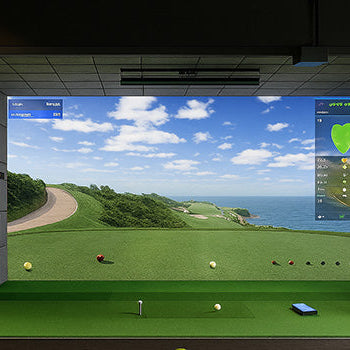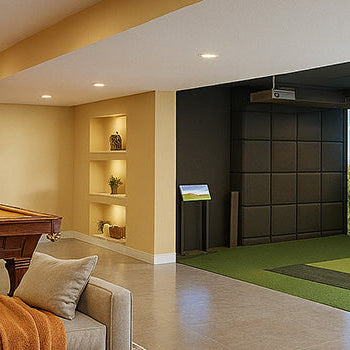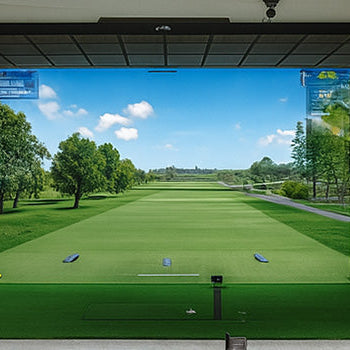Dreaming of teeing off without leaving the house? A home Golf Simulator sounds like the perfect escape, until planning permission swings into the picture.Short answer: You might need it, depending on how and where you install it.
If you don’t want the council showing up mid-backswing, keep reading. We’re breaking down what you can and can’t do, without the legal jargon or surprises.

The General Rule: Internal vs. External Changes
Here’s the big question: are you using a space inside your home, or are you building something entirely new?
That’s where planning permission lines are drawn.
Internal setups? Usually fine. Building a new structure? Now you’re on the council’s radar.
Let’s break it down.
Internal Setups: Why You Typically Don't Need Permission
If your golf simulator is going inside an existing room. Like a garage, loft, or spare bedroom, you're probably in the clear.
These kinds of installations don’t change how your home looks from the outside. That means they rarely trigger planning permission requirements.
A quick example: converting your garage into a golf room? Usually fine. Adding a window or door? You might need approval.
It’s not about the simulator, it’s about what you’re changing to make it work.
When is a Simulator Considered an "Internal Modification"?
If your project doesn’t involve changing the building’s footprint, knocking down major walls, or installing plumbing, it’s likely classed as an internal modification.
Think: installing a screen, adding turf flooring, maybe a projector and net.
As long as it stays inside the four walls and doesn't change the external appearance of the home, you’re usually safe.
Even adding ventilation or extra wiring for lighting won’t cause a problem, just make sure it's done properly.
The Key Distinction: Building a New Structure
Now, if you’re thinking, “I’ll just pop a simulator into a lovely new garden room,” slow down.
As soon as you’re building a new structure. Shed, cabin, summerhouse, anything, it’s a whole new ballgame.
You’ll need to consider things like height, size, and distance from boundaries.
This is where planning permission often comes into play.

Scenario 1: Installing a Simulator Inside Your Home or Garage
Most people go this route because it’s the simplest.
Less red tape. Fewer surprises. And often, no formal permission needed.
Permitted Development Rights Explained
In the UK, many home improvements fall under something called Permitted Development Rights.
This means you can carry out certain changes, like converting an internal space, without needing to submit a planning application.
If you’re not extending, building outwards, or altering the structure’s appearance, you’re likely covered.
Always good to double-check, but most internal golf simulators tick the right boxes.
Considerations for Listed Buildings or Conservation Areas
If your home is listed or in a conservation area, though? Different rules apply.
Even minor internal changes could require Listed Building Consent.
So if your dream simulator is going into a centuries-old cottage with original beams and stone walls, talk to your council first.
It’s not about stopping your project, it’s about preserving the character of the property.
What About Building Regulations? (e.g., Electrics, Ventilation)
Even if planning permission isn’t needed, building regulations still matter, and for good reason.
You’ll need:
-
Safe, professionally installed electrics
-
Adequate ventilation (those simulators can get toasty!)
-
Possibly soundproofing, especially in shared or attached homes
If your install involves structural changes or heavy-duty electrics, get it signed off by the right people. Better safe than rewired.
Scenario 2: Building a Dedicated "Golf Shed" or Outbuilding
Now for the folks eyeing up the garden and thinking: “That’s my future golf zone.”
This is totally possible, but trickier.
When an Outbuilding Falls Under Permitted Development
Believe it or not, you can build a golf simulator garden room without planning permission, if you stay within the limits.
These include:
-
No higher than 2.5 metres (if it’s within 2 metres of your boundary)
-
Not taking up more than 50% of your total garden space
-
It must be for incidental use, so not a full-on living space
If your outbuilding fits those rules, it likely falls under Permitted Development.
Key Limitations: Height, Size, and Location
Here’s where people get tripped up. You’ve got your golf shed designed and ready, until someone tells you it’s too tall or too close to the fence.
Outbuildings over 2.5m high or too close to boundaries often need permission.
And if you’re planning something big and fancy. Think aircon, plumbing, heating, or heavy equipment, you’ll need to get clearance.
Rule of thumb: the simpler and smaller it is, the less likely you'll need to deal with paperwork.
When You Will Almost Certainly Need Planning Permission
Some builds are just too bold to fly under the radar.
You’ll almost definitely need permission if:
-
You live in a conservation area or AONB (Area of Outstanding Natural Beauty)
-
The outbuilding includes heating, water, or a toilet
-
You’re adding a large, year-round structure with foundations
-
You're changing the use of the building (e.g., full-time studio or business)
In short, the more permanent and “liveable” your simulator space becomes, the more likely it’ll need approval.
Commercial vs. Residential Use
Let’s be honest, some of us aren’t just swinging for fun. Maybe you’re a coach. Maybe you're thinking content creation. Maybe you see a side hustle brewing.
Here’s where the rules get serious.
The Impact of "Change of Use" on Planning Requirements
If you use your golf simulator for personal recreation, no problem.
But if the council sees you using it for commercial gain, they could require planning permission due to a change of use.
This could apply even if you’re operating from home, especially if customers are visiting.
Are You Planning to Run a Business From Your Simulator?
Running coaching sessions, charging for tee time, or even turning it into a YouTube studio? That’s a business.
As soon as money changes hands, you may need permission.
And if traffic increases or neighbours complain? The council could investigate.
Plan ahead, and get it approved properly if business is part of the plan.

How to Be Certain: When in Doubt, Check with Your Local Council
Here’s the golden rule: Always double-check.
No matter how confident you are, it’s worth confirming with your local planning authority.
Finding Your Local Planning Authority (LPA)
You can find your LPA through the UK Planning Portal.
Once you’ve got your postcode plugged in, you can explore local rules and even see similar applications in your area.
The Benefits of Seeking Pre-Application Advice
Not sure if your setup needs permission? Ask.
Pre-application advice is like asking the teacher before the test.
For a small fee (or sometimes free), your local authority can review your golf simulator garden room plans and flag any issues early on.
It’s faster, cheaper, and way less stressful than getting told to tear something down later.










